Nam June Paik Art Center Special Exhibition Ecologicaal Sense
Period/ 2019.07.05(Fri) ~ 2019.09.22(Sun)
Venue/ Nam June Paik Art Center Gallery 2
■ Overview
Exhibition Title
Nam June Paik Art Center Special Exhibition – Ecological Sense
Period
5 July 2019 – 22 Setember 2019
Venue
Nam June Paik Art Center 2F
Opening
5 July 2019 (Fri) 4pm
Curated by
Jeonghwa Goo(Curator, Nam June Paik Art Center)
Artists
Rice Brewing Sisters Club, Listen to the city, Minha Park, Park Sunmin, Nam June Paik, Anaïs Tondeur, Jiyoung Yoon, Soyo Lee, Jenin Kii, Eunji Cho
Organized and Hosted by
Nam June Paik Art Center,
Gyeonggi Cultural Foundation
Gyeonggi Cultural Foundation
Supported by
Sandoll Cloud
The current age called Anthropocene by many scientists is addressing the emerging realities of a post-nature world such as climate change and environmental crisis. Once the stuff of sci-fi movies, the apocalypse of global extinction has made its way into our life—including our daily meals and fine particulate matter we inhale during our commutes to work— and redefines it. Constantly growing mountains of garbage, oceans polluted by plastics and radioactive materials, and aggravating desertification are now part of our environment and everyday scenes. Humans, who are placed at the top of the hierarchy of earth inhabitants, obtain information only from capitalized platforms, live only space and time confined by media, and consume only senses given to them. They keep on using an earth instruction manual saying that you can bury everything underground just for the sustainability of humankind.
The exhibition Ecological Sense begins with these questions: then, is it reasonable to trust them, this top predator with highly biased sensibilities, with the future of the earth? And what is the ecological prospect that they ought to have for the survival of all living organisms on the planet including themselves? The participating artists are wary of the undeserved status of human beings in charge of manipulating the earth system, earnestly hoping to find them a new ecological position, or niche, in relationships with other earth inhabitants. The exhibition’s spatial design reflects the process of ‘succession’ which means gradual ecological changes occurring in interaction with numerous living and non-living things, ranging from garden plants and insects, mushrooms and microorganisms deep in forests, octopuses in the sea, and salamanders, to minerals, a long time old friend of human technology. The ‘ecological literacy’ for this kind of change comprises elements of eco-friendly sensibility which modern individuals should recover, staying away from increasingly being absorbed in information transfer and technological accumulation in the segmented society and beginning to consider the whole global environment. Like the philosopher who said he would plant an apple tree if he knew the world would end tomorrow, we hope viewers will be able to turn around the corner of catastrophe and apocalypse and be connected to new other inhabitants on this planet, inspired by the energy of communication.
The exhibition Ecological Sense begins with these questions: then, is it reasonable to trust them, this top predator with highly biased sensibilities, with the future of the earth? And what is the ecological prospect that they ought to have for the survival of all living organisms on the planet including themselves? The participating artists are wary of the undeserved status of human beings in charge of manipulating the earth system, earnestly hoping to find them a new ecological position, or niche, in relationships with other earth inhabitants. The exhibition’s spatial design reflects the process of ‘succession’ which means gradual ecological changes occurring in interaction with numerous living and non-living things, ranging from garden plants and insects, mushrooms and microorganisms deep in forests, octopuses in the sea, and salamanders, to minerals, a long time old friend of human technology. The ‘ecological literacy’ for this kind of change comprises elements of eco-friendly sensibility which modern individuals should recover, staying away from increasingly being absorbed in information transfer and technological accumulation in the segmented society and beginning to consider the whole global environment. Like the philosopher who said he would plant an apple tree if he knew the world would end tomorrow, we hope viewers will be able to turn around the corner of catastrophe and apocalypse and be connected to new other inhabitants on this planet, inspired by the energy of communication.
Participating Artists and works
Nam June Paik, Apple Tree, 1995
410×280×110cm, 33 TVmonitors, 3 channel video / courtesy of Daelim Cultural Foundation 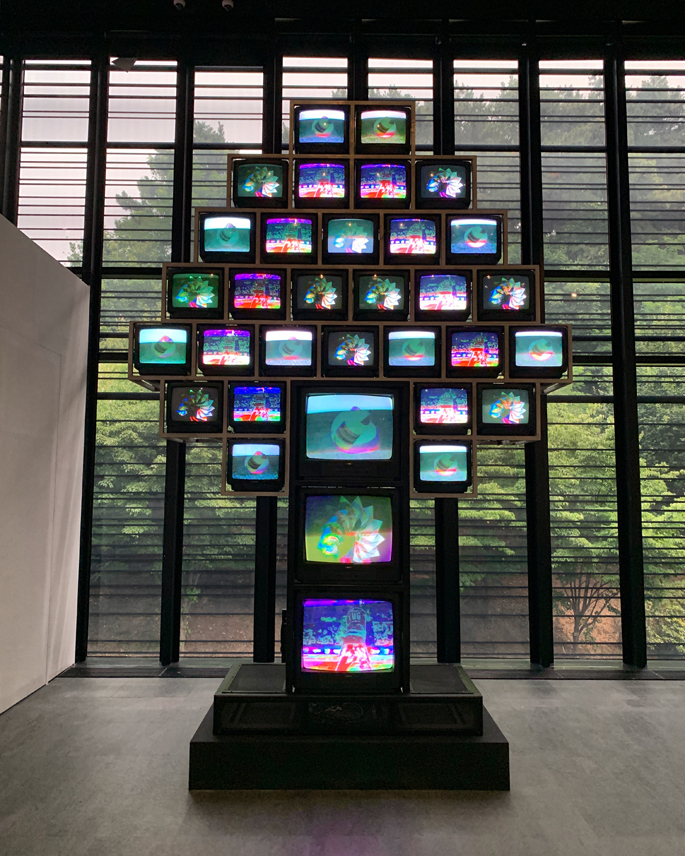
Ecologically, trees are important because they create an environment for living organisms on this planet, including humans, by capturing solar energy and releasing oxygen during photosynthesis. TV, a device that emits light for itself and receives electric waves, does much the same; it plays a vital part in the media environment to shape our lives. This tree-shaped media sculpture made up of 33 TV monitors, Apple Tree, shows what Nam June Paik meant by saying that “TV is an environment,” from the perspective of media ecology. Its radiating lights and images from Olympic Games, a dense complex of buildings, and female nudes, or those of geometric, fish, and bird patterns, whose signal are sent by a video divider, will activate our perception and even expand its boundaries.
Lee Soyo, TV Garden: Notes, 2019
dimension variable, field study and multimedia installation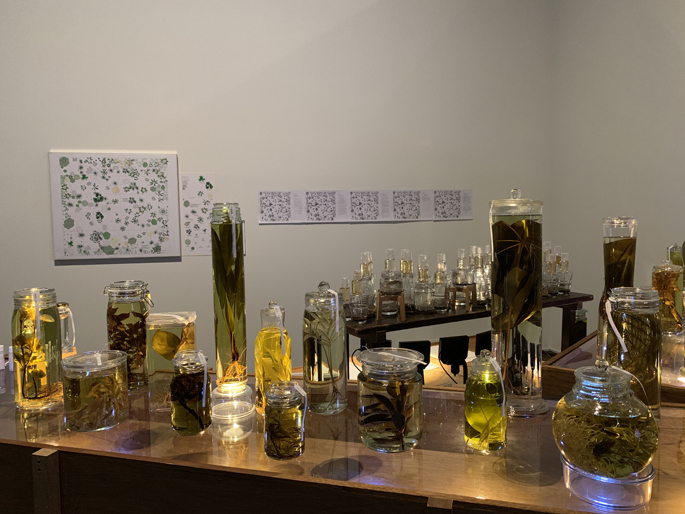
Soyo Lee has been preoccupied with cultural practices to reduce living organisms and ecology to visual information or art, as well as methodologies and values shared among biology, natural history, and art. In this exhibition, Soyo Lee regarded Paik’s TV Garden, installed in the first-floor lobby of Nam June Paik Art Center, as a micro-ecological community and surveyed its biota as comprehensively as possible, keeping a journal and making samples. While in the initial installation, dating back as far as the 1970s, visitors could metaphorically understand Paik’s intention through the green leaves of foliage plants in pots, the present version, having accompanied the 10-year history of the center, has created a real ecosystem: in this typical indoor garden, various members of living systems, such as bacteria, fungi, mushrooms, insects and worms, plants, and humans, interact with each other. This project makes visible the living things in a work of art, which have been made invisible for being small or trivial, and provides a new commentary on TV Garden from the perspective of the modern ecological criticism.
Jiyoung Yoon, juxtaposed, 2019
dimension variable, glass, steel, microplastics, styrofoam, silicon, latex, etc
mechanical design & builct : Choi, Moon Seok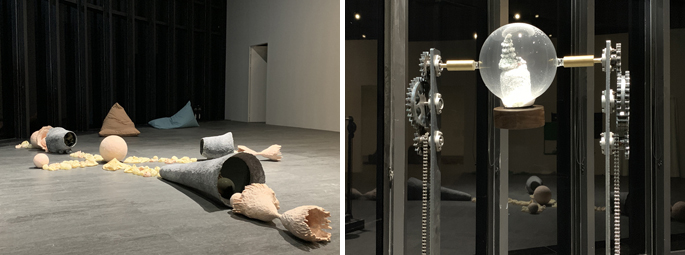
Jiyoung Yoon has translated individuals’ attitude or way of accepting situations or events into the sculptural language, with particular focus on the efforts and sacrifices required to adapt themselves to common goals or given conditions. Yoon’s sculptures, produced through psychological interpretations of emotions such as belief or anxiety, create very detailed and realistic situations, hoping to start the process of finding balance and compromising in them. For this exhibition, Yoon made a kinetic sculpturesusing materials which were made to serve human wants, such as comfort, pleasure, and prettiness. A snow globe produced for a momentary joy and a balls filled with helium, a gas derived only from the extraction of natural gas, are symbols of the human desires, while the ecological sensitivity. Yoon has as a sculptor dealing with materials is reflected on the skin-shedding sculptures. The artist’s whole life continually creating something is staged as a scene.
Minha Park, Dialogue 77-08-12, 2019
dimension variable, sound installation, fluorescence mural, black light, revolving stool *sound production: Minha Park X InChul Cho
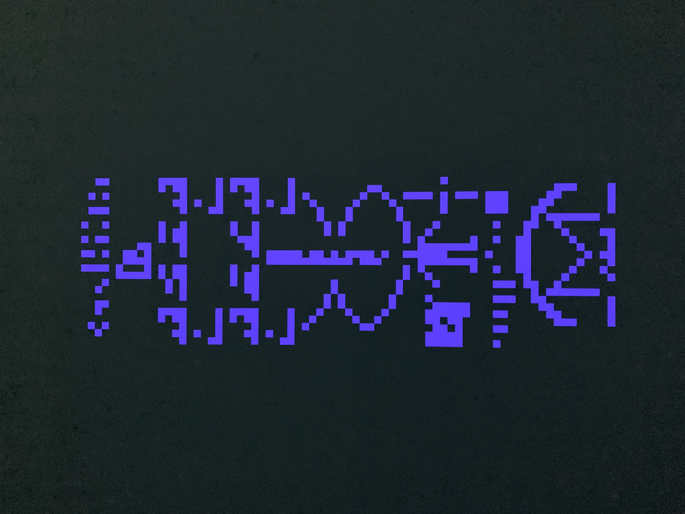
Minha Park, who has an interest in illusions, images, and fantasies people create to transcend the physical world, is known for working on cinematic special effects and the magical effect of early films. Dialogue 77-08-12 is made up of the archive of various sounds sent into space from 1962 to 2012 and the visual signs, also sent to space, such as the Moon Museum hidden on the Apollo 12 in 1969, and the images of the earth and the Nazca lines in Peru which were included on the Golden Records attached to the Voyager 1 and 2 spacecraft launched in 1977. These visual signs lit by black lights in the darkness and the audio signals filling the dark room construct a space theater bearing the traces of dialogues which have not yet reached or completed. Humankind’s effort to communicate with possible extraterrestrial beings expands our imagination and understanding of other creatures, as well as makes us pay attention to both the limitations and possibilities of our Spacecraft Earth.
Jenin Kii, Precursor-I, 2019
dimension variable, mixed media composed of PVC(poly Vinyl Chloride)m sheets, ferofluid( magnetite, oil soluble, distilled petroleum), awter, soap, sand, powder magnet, electromagnets, various electronic parts
Jenin Kii, Precursor-II, 2019
1 channel video, sound, color, 12:01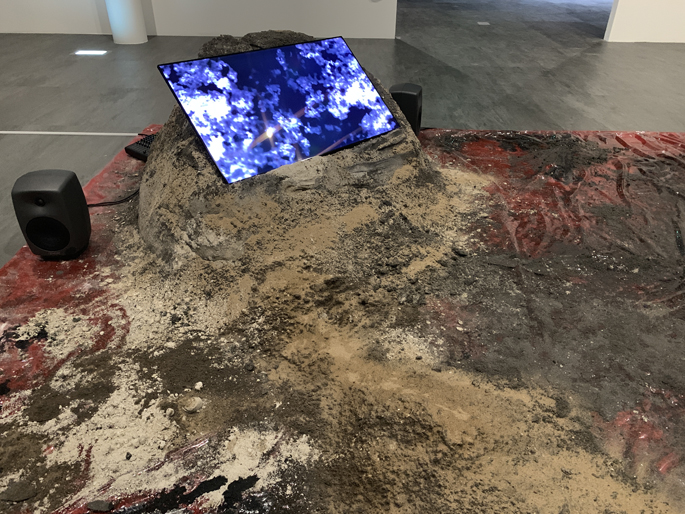
Precursor reflects on the moments that humans have had and will have with technology. Jenin Kii tries to imagine the ecological relationship between man and technology with the belief that media must have developed in interaction with the global environment in geological strata for thousands of years. Inspired by the concept of precursor, a substance from which another substance is formed by a metabolic or chemical reaction, the artist tests the conventional sense about media, breaks down the fixed sense of it, and structuralizes newness. Substances show subtle movement due to low electrical activation, offering synesthetic experiences which are strange to viewers. To look back at the situations when humanity went with technology, the artist also refers to non-modern sensibilities or perspectives such as techno-animism, meaning the culture or thought where humans, technology, and spirituality fuses into one.
Anaïs Tondeur, Carbon Black, 2016-2018
100x150cm, black carbon print, cartographies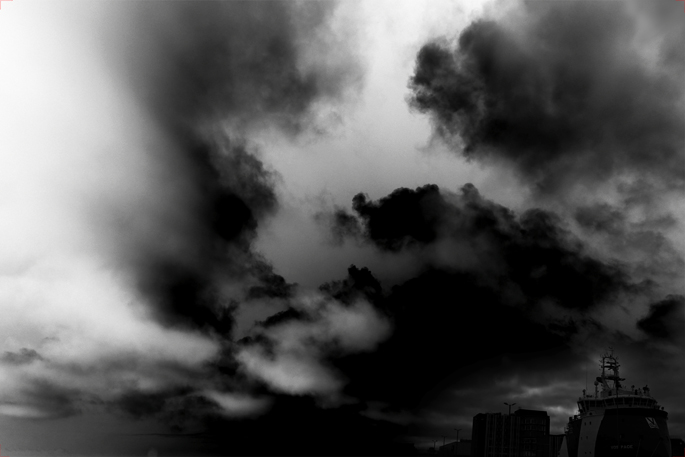
Carbon black – North Sea
Carbon Black is a series of photographs recording the artist’s 15 day traverse from Scotland to South East England, tracking the traces of carbon particles. Black carbon particles are a product of incomplete combustion of coal, lignite, heavy oil or biomass and also emitted in traffic and industrial activities, road erosion and tire wear. These pollutant particles disperse with the wind and can be transported hundreds of kilometers away from the original source of the pollution. During this expedition, the artist gathered black carbon particles through a specially designed device and later used them to print the photos. This walking device, consisting of a respiratory mask and a camera, provided the raw materials for this ‘walking photography,’ enabled her to participate in the interaction between air and human activities, and proposes a common ground which reflects our new way of being and fairness.
Anaïs Tondeur, Chernobyl Herbarium, 2011∼2016
Location: Exclusion Zone, Chernobyl, Ukraine_Radiation level: 1.7 Microsieverts per hour
36x24cm, 30 rayograms, pigment print on hahnemühle paper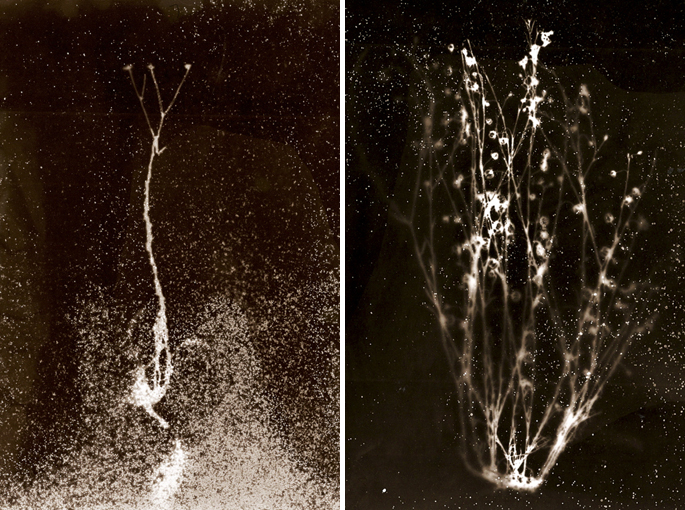
Chernobyl Herbarium is a collection of plant specimens from the Exclusion Zone established soon after the Chernobyl nuclear power plant accident on 26, April 1986. This work is based on the bio-genetic research of Martin Hajduch in the Institute of Plant Genetics and Biotechnology at Slovak Academy of Sciences who investigated traumas endured by the flora in these areas of high radiation. Anaïs Tondeur made imprints of specimens of 30 Linaceae species using a photogram process, a technique that reflected the effect of exposure to light emitted by the atomic bomb during its explosion. These shadowy images on light-sensitive paper, which were made by the plants by being exposed to light, though not real radiation, are material traces or visible silhouettes of the invisible disaster. Through photograms, the artist liberates the light (trauma) locked in the plants without repeating the Chernobyl accident.
Eunji Cho, Octopusy Ecstasy, 2019
1 channel video, stereo sound, 08:08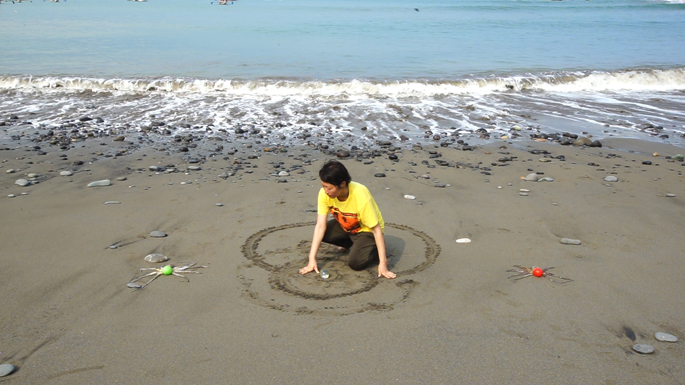
This video began with the Indonesian myth that every newborn baby has a twin brother in the form of an octopus. The artist attempts to imagine languages or competencies that we might have had before we were born, through such performances as yoga, meditation, altering the state of consciousness, etc., with the background of the beach and the underwater landscape of Island. Considering the possibility of multiple selves, this video proposes viewers to reset the boundaries between different beings.
Listen to the City, Placelessness: Naeseong River, Gureombi, and Okbaraji Alley,
2017/2019, 3 channel video, color, sound, 18:17
Listen to the City, an art-design-urbanism activism collective, works to give visibility to unwritten histories of cities. Placelessness: Naeseong River, Gureombi, and Okbaraji Alley is the collective’s record of particular places in Korea and those who tried to protect them since 2009. Okbaraji Alley vanished in an instant due to the government’s urban redevelopment plan, though having survived the Japanese military occupation of Korea and the developmental dictatorship in the 1970s; the creatures living in Naeseong River underwent rapid change during and after the Four Major Rivers Project; and in Gangjeong village, construction of a new naval base finally started. “Then, why did we fail to protect them?” the video asks. Delivering the stories of the people who struggled to save these places, not leaving them even after witnessing all those changes and destructions, the collective directs its attention to ‘placelessness,’ the sentiment which has infiltrated our daily senses. And the artists also turn up the volume of the voices of feeble inhabitants which became invisible after having disappeared and been forced out by construction and movement of urban ecosystems, a general habitat of humankind.
Park Sunmin, Architecture of Mushroom, 2018
1 channel video, color, sound, 15:05
Architecture of Mushroom is a video of low angle, slow-motion shot of mushrooms growing in the Gotjawal forest, Jeju, Korea, taken over a year in 2017, which is accompanied by 13 Korean and foreign architects’ narrations on architecture. Mushrooms, as a kind of fungi, obtain nutrients by decomposing organic matter and thereby play an essential role in the ecological cycle of creation and decay of the forest. On the other hand, they are a living creature with an architectural structure composed of a column and a roof. In this age when materials pose a threat to both man and nature since they never diminish or disappear due to mass production, the growing and fading of mushrooms, sometimes in contrast to and at other times in harmony with various architectural issues, inspires viewers to imagine the relationship between man and nature in a new way.
Rice Brewing Sisters Club, Fermentcult, 2019
dimension variable, mixed media, 4 channel video, color, silent(loop)
Rice Brewing Sisters Club, a collective continually attempting to make collaborations and relations, extends the meaning of fermentation to a metaphor of ‘social fermentation.’ This temporary community, whose membership is renewed annually and whose members love to express the sensual beauty of life in their unique way within the boundary of the group, tracks the stories of individuals and communities who voluntarily practice alternative ways of living. Fermentcult is a project to rethink the fermentation culture in the foreboding of the end of our era and imagine it as a way of life to break through in the crisis under the slogan that ‘Fermentation is an Old Future.’ Regarding numerous trials and errors, unpredictability, organic changes, and the porous temporality as a kind of alternative way of living, the collective focuses on the process in which humanity, the predator in control of the earth, obtains knowledge and sensations from nonhuman beings. The artists present a ‘fermentation kit,’ proposed by a media theorist, a microbiologist, a novelist, etc., in the exhibition room and hold a workshop during the exhibition. Workshop participants could enjoy the opportunity to build a new process of evolution, by imagining his or her or their community’s future in light of fermentation, using three keywords of time, body, and the earth.
















